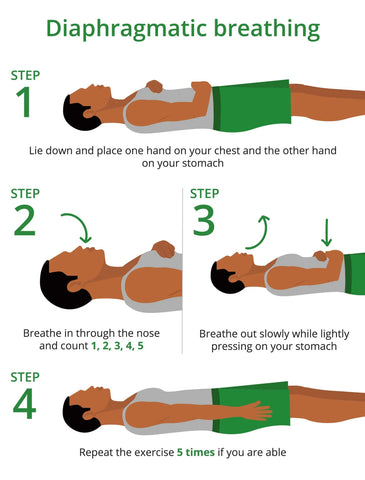Proper breathing is fundamental to overall respiratory health, yet many people unknowingly develop improper breathing patterns that affect their oxygen intake and overall well-being. Whether caused by stress, poor posture, or underlying medical conditions, incorrect breathing can lead to fatigue, dizziness, and even long-term health complications. This guide will help you identify improper breathing patterns and explore effective breathing exercises to correct them.
Understanding Improper Breathing Patterns
Improper breathing patterns can manifest in various ways, including:

-
Shallow breathing – Taking short, quick breaths that do not fully expand the lungs.
-
Chest breathing – Relying on the upper chest rather than the diaphragm.
-
Mouth breathing – Habitually breathing through the mouth instead of the nose.
-
Over-breathing (hyperventilation) – Breathing too rapidly, often due to stress or anxiety.
Identifying your breathing habits is the first step toward improving your respiratory health. Now, let’s explore ways to correct these patterns.
Practical Techniques to Improve Breathing
1. Diaphragmatic (Belly) Breathing
One of the most effective breathing exercises for correcting improper breathing is diaphragmatic breathing. This method encourages deep breaths from the diaphragm rather than shallow chest breathing.

How to do it:
-
Sit or lie down in a comfortable position.
-
Place one hand on your chest and the other on your abdomen.
-
Inhale deeply through your nose, ensuring your stomach expands while your chest remains still.
-
Exhale slowly through your mouth, feeling your belly contract.
-
Repeat for 5–10 minutes daily to enhance respiratory health.
2. Nasal Breathing
Mouth breathing can lead to reduced oxygen absorption and increase the risk of respiratory infections. Practicing nasal breathing ensures optimal oxygen exchange and improves lung function.

How to do it:
-
Make a conscious effort to breathe through your nose throughout the day.
-
If nasal congestion is an issue, consider saline rinses or consulting a specialist.
-
Practice alternate nostril breathing to train your body to prefer nasal breathing.
3. Box Breathing (Four-Square Breathing)
This structured breathing exercise helps regulate oxygen levels and promotes relaxation.

How to do it:
-
Inhale through your nose for 4 seconds.
-
Hold your breath for 4 seconds.
-
Exhale slowly for 4 seconds.
-
Pause for 4 seconds before repeating the cycle.
Practicing this method for 5–10 minutes a day can significantly improve respiratory health.
4. Pursed-Lip Breathing
Pursed-lip breathing helps slow down breathing, increase oxygen intake, and improve lung efficiency.

How to do it:
-
Inhale deeply through your nose.
-
Purse your lips as if you are about to whistle.
-
Exhale slowly and steadily through your pursed lips, taking twice as long as your inhale.
-
Repeat for several minutes, especially when feeling breathless.
5. Posture Correction
Poor posture, particularly slouching, can restrict lung expansion and lead to inefficient breathing.

How to improve posture for better breathing:
-
Sit upright with shoulders relaxed and spine aligned.
-
Avoid hunching over screens and desks for long periods.
-
Engage in exercises such as yoga or pilates to strengthen core muscles that support breathing.
6. Physical Activity and Breath Control
Regular exercise improves lung capacity and respiratory health. Activities such as swimming, running, and yoga encourage controlled breathing exercises, enhancing oxygen delivery throughout the body.

Breathing tips during exercise:
-
Inhale through the nose and exhale through the mouth for better oxygen exchange.
-
Use rhythmic breathing patterns to maintain endurance.
-
Avoid shallow breaths by focusing on deep, controlled inhalations.
The Role of Oxygen Therapy in Correcting Breathing Patterns
For individuals with chronic respiratory conditions or severe breathing difficulties, oxygen therapy can be a valuable aid. Supplemental oxygen helps improve oxygen levels in the blood, reducing symptoms such as breathlessness and fatigue.
Oxygenvip provides high-quality oxygen concentrators designed to enhance respiratory health. Whether for home or portable use, our devices support proper breathing and overall wellness.
Breathing Training Device – Lung Breathing Exercise & Mucus Removal Device
Using a breathing training device can further support efforts to restore proper breathing patterns. Oxygenvip offers a Lung Breathing Exercise & Mucus Removal Device, designed to enhance respiratory health and aid those with chronic breathing issues.
Product Features:
-
Breathing Trainer – Incorporates Oscillating Positive Expiratory Pressure (OPEP) and airway vibration technology to loosen mucus and clear airways.
-
Safe & Hygienic – Made from non-toxic, odorless materials with detachable components for easy cleaning and maintenance.
-
Adjustable Resistance Levels – Features a resistance adjuster to customize the resistance level according to individual needs and progress.
-
Restore Normal Breathing – Beneficial for individuals with chronic bronchitis, asthma, COPD, cystic fibrosis, and other respiratory conditions.
-
Portable & Compact – Lightweight design with an included lanyard for easy use at home, work, or while traveling.
Incorporating a breathing training device into your daily routine can help strengthen lung capacity, improve mucus clearance, and restore effortless breathing.
Final Thoughts
Correcting improper breathing patterns is essential for optimal respiratory health. Incorporating these breathing exercises into your daily routine can help you breathe more efficiently, improve lung function, and enhance your overall well-being.
If you struggle with chronic breathing issues, consult a healthcare professional for personalized advice. Explore Oxygenvip’s range of oxygen therapy solutions and breathing training devices to support your journey toward healthier breathing.

















